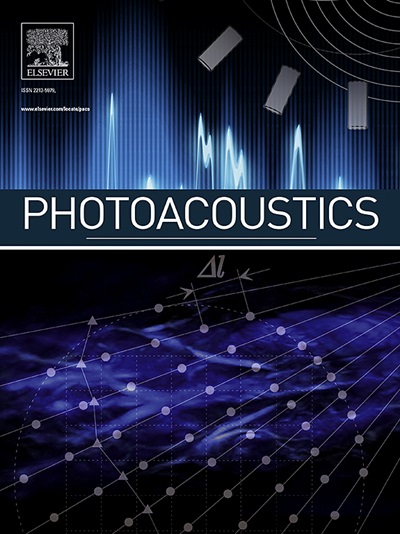定量光声成像使用已知的发色团作为通量标记。
IF 7.1
1区 医学
Q1 ENGINEERING, BIOMEDICAL
引用次数: 0
摘要
光声成像在声学分辨率下提供人体组织的光学对比图像,使其在各种临床应用中具有价值。然而,由于组织内未知的光影响,通过光学对比定量组织成分仍然具有挑战性。在这里,我们提出了一种方法,利用已知的发色团(例如,动脉血液)来提高定量光声成像的准确性。通过使用已知的发色团的光学性质作为通量标记,并将其集成到光学反演过程中,我们可以估计组织内的未知通量。实验表明,该方法成功地恢复了未知发色团的光谱形状和光吸收系数的大小。此外,我们表明,影响力标记方法增强了传统的光学反演技术,特别是(i)直接迭代方法和(ii)基于梯度的方法。我们的结果表明,在使用和不使用通量标记时,光学吸收回收率的准确度提高了24.4%。最后,我们介绍了该方法的性能,并举例说明其在颈动脉斑块定量中的应用。本文章由计算机程序翻译,如有差异,请以英文原文为准。
Quantitative photoacoustic imaging using known chromophores as fluence marker
Photoacoustic imaging offers optical contrast images of human tissue at acoustic resolution, making it valuable for diverse clinical applications. However, quantifying tissue composition via optical contrast remains challenging due to the unknown light fluence within the tissue. Here, we propose a method that leverages known chromophores (e.g., arterial blood) to improve the accuracy of quantitative photoacoustic imaging. By using the optical properties of a known chromophore as a fluence marker and integrating it into the optical inversion process, we can estimate the unknown fluence within the tissue. Experimentally, we demonstrate that this approach successfully recovers both the spectral shape and magnitude of the optical absorption coefficient of an unknown chromophore. Additionally, we show that the fluence marker method enhances conventional optical inversion techniques, specifically (i) a straightforward iterative approach and (ii) a gradient-based method. Our results indicate an improvement in accuracy of up to 24.4% when comparing optical absorption recovery with and without the fluence marker. Finally, we present the method’s performance and illustrate its applications in carotid plaque quantification.
求助全文
通过发布文献求助,成功后即可免费获取论文全文。
去求助
来源期刊

Photoacoustics
Physics and Astronomy-Atomic and Molecular Physics, and Optics
CiteScore
11.40
自引率
16.50%
发文量
96
审稿时长
53 days
期刊介绍:
The open access Photoacoustics journal (PACS) aims to publish original research and review contributions in the field of photoacoustics-optoacoustics-thermoacoustics. This field utilizes acoustical and ultrasonic phenomena excited by electromagnetic radiation for the detection, visualization, and characterization of various materials and biological tissues, including living organisms.
Recent advancements in laser technologies, ultrasound detection approaches, inverse theory, and fast reconstruction algorithms have greatly supported the rapid progress in this field. The unique contrast provided by molecular absorption in photoacoustic-optoacoustic-thermoacoustic methods has allowed for addressing unmet biological and medical needs such as pre-clinical research, clinical imaging of vasculature, tissue and disease physiology, drug efficacy, surgery guidance, and therapy monitoring.
Applications of this field encompass a wide range of medical imaging and sensing applications, including cancer, vascular diseases, brain neurophysiology, ophthalmology, and diabetes. Moreover, photoacoustics-optoacoustics-thermoacoustics is a multidisciplinary field, with contributions from chemistry and nanotechnology, where novel materials such as biodegradable nanoparticles, organic dyes, targeted agents, theranostic probes, and genetically expressed markers are being actively developed.
These advanced materials have significantly improved the signal-to-noise ratio and tissue contrast in photoacoustic methods.
 求助内容:
求助内容: 应助结果提醒方式:
应助结果提醒方式:


